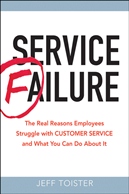Spreadsheet Jockeys are clueless about retail service
 Jeff Toister
Jeff Toister  Tuesday, January 29, 2013 at 9:01AM |
Tuesday, January 29, 2013 at 9:01AM | All super heroes have at least one nemesis. Batman has the Joker. Superman has Lex Luther. Outstanding Service has the Spreadsheet Jockey.
What’s a Spreadsheet Jockey? It’s an executive who designs systems and strategies to serve their customers based on data points and intuition without gathering any input from the people who are actually serving customers.
The sad, inevitable result of Spreadsheet Jockey management is service failure. Here are three examples where a spreadsheet jockey designed a system that any frontline employee could tell you would fail.
Upsell or No Sell at Staples
A month or so ago, I read an incredible story on Bruce Temkin’s blog that described how employees at Staples office supply stores were refusing to sell computers to customers who didn’t accept any of their upsell offers.
You might be tempted to say, “Fire those scoundrels!” until you learned that a fear of being fired was the cause of their behavior.
A Spreadsheet Jockey at Staples had created a standard that required sales associates to average $200 in add-ons for each computer they sold. The penalties for failing to meet the standard included progressive discipline and possible termination. While designed to increase revenue, the new policy actually gave employees a strong incentive to avoid selling computers altogether.
Why?
Let’s say you sell a computer to a customer who doesn’t buy anything else. That’s $0 in upsells on that computer, so you’d need to sell $400 in add-ons on your next computer sale to maintain the $200 average and avoid getting fired. That made a person who didn’t want any add-ons a threat to your job unless you could somehow ensure the sale didn’t go through.
A $100 solution to a $20 problem
My wife recently returned a briefcase to the store where she bought it so it could be repaired under warranty. The leather zipper pull on the main compartment had torn off, which would have been a simple repair if the luggage store had an onsite repair shop.
The fact that it couldn’t do the repair onsite shouldn’t have been a major obstacle. In a normal, sane world, the luggage store would have a relationship with a local repair shop that could help them facilitate the repair within a day or two. They might even have an authorized repair center in town that could provide same day service if my wife was willing to do a little driving.
Unfortunately, things are never that easy for customers when a Spreadsheet Jockey designs the system. The luggage store’s actual process involved shipping my wife’s bag to their corporate repair depot in New York, making my wife wait an estimated four weeks, and then shipping the bag back to our home in San Diego.
In the end, it made more sense for my wife to pay to get the repair done at a local shop than to be without her bag for four weeks while she waited for it to be repaired under warranty.
Labor models can’t see inside your store
I recently spoke with a friend who works in a retail pet store that is continuously victimized by corporate Spreadsheet Jockeys.
Exhibit A is Saturday morning, the store’s busiest time of the week. My friend would love to schedule extra sales staff to help boost sales, but his hands are tied in two ways.
First, the store’s labor model doesn’t allow him to bring in extra staff. A labor model is a tool often used in retail that tells each store how many employees they can have on each shift. It is a Spreadsheet Jockey invention that relies on data analysis to optimize labor costs, but it can also take away an individual store’s ability to react to opportunities such as a busy Saturday morning.
The second problem was the store had to take associates off the sales floor to process the weekly stock shipment. The delivery schedule was set by another Spreadsheet Jockey to optimize delivery logistics, but it didn’t factor in the impact on operations. The store had limited overstock space, so they had to get the new stock unboxed and out on the sales floor as quickly as possible. Replenishing stock is also a labor intensive job that’s usually done during slower periods, not on a busy Saturday morning when they should be helping customers and generating revenue.
A simple cure
Adam Toporek recently wrote an excellent post on his CustomersThatStick blog about the virtues of management by walking around in a customer service environment. His was point was that Spreadsheet Jockeys need to temper their data analysis with a dose of reality.
Look at the best retail operations and you'll see this happening. Executives are constantly spending time in their stores, asking questions, and observing. They realize that nobody understands their challenges better than associates, and those same associates probably have some good ideas about how to fix them.





